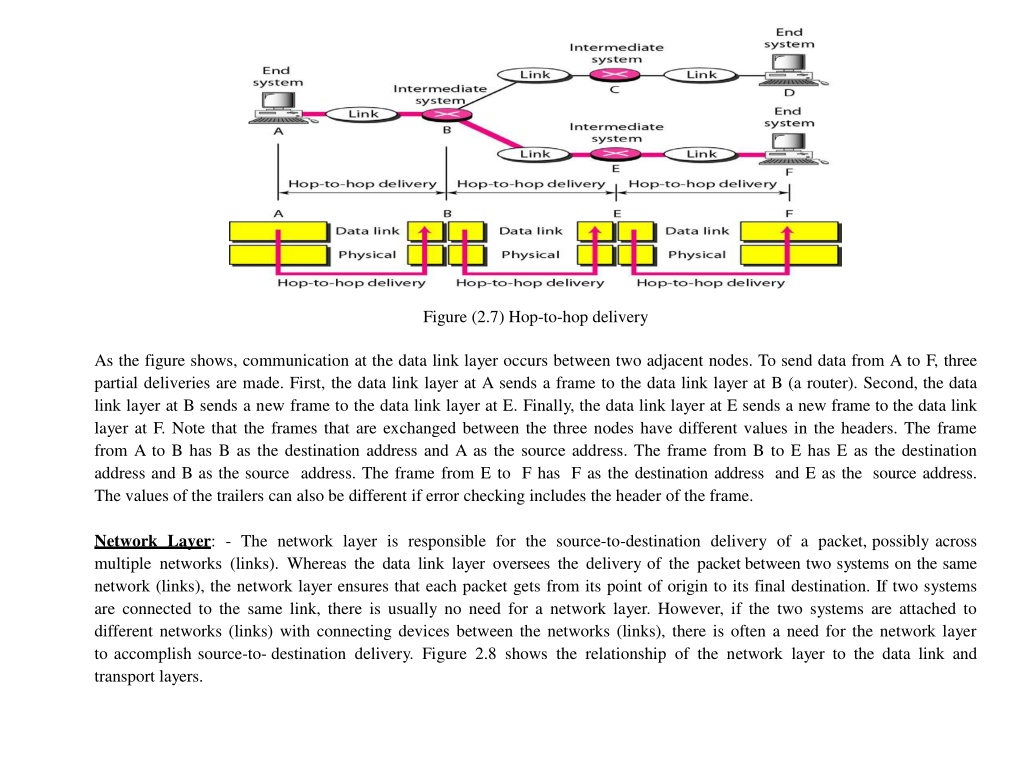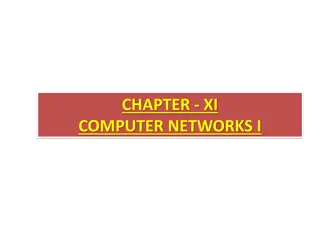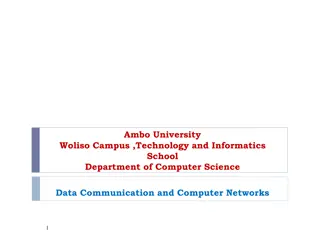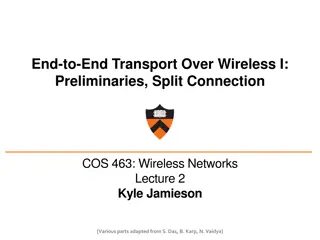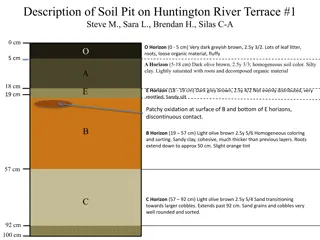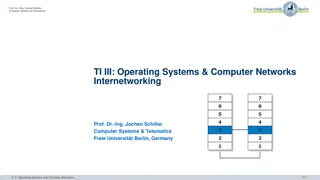Understanding Communication Layers in Computer Networks
Communication in computer networks is facilitated through different layers such as the data link, network, and transport layers. Each layer has specific responsibilities in ensuring data delivery from one point to another. The data link layer handles communication between adjacent nodes, the network layer manages source-to-destination packet delivery, and the transport layer ensures end-to-end delivery of messages between processes. This breakdown helps in understanding the flow of data and enables smooth communication in networked environments.
Download Presentation

Please find below an Image/Link to download the presentation.
The content on the website is provided AS IS for your information and personal use only. It may not be sold, licensed, or shared on other websites without obtaining consent from the author. Download presentation by click this link. If you encounter any issues during the download, it is possible that the publisher has removed the file from their server.
E N D
Presentation Transcript
Figure (2.7) Hop-to-hop delivery As the figure shows, communication at the data link layer occurs between two adjacent nodes. To send data from A to F, three partial deliveries are made. First, the data link layer at A sends a frame to the data link layer at B (a router). Second, the data link layer at B sends a new frame to the data link layer at E. Finally, the data link layer at E sends a new frame to the data link layer at F. Note that the frames that are exchanged between the three nodes have different values in the headers. The frame from A to B has B as the destination address and A as the source address. The frame from B to E has E as the destination address and B as the source address. The frame from E to F has F as the destination address and E as the source address. The values of the trailers can also be different if error checking includes the header of the frame. Network Layer: - The network layer is responsible for the source-to-destination delivery of a packet, possibly across multiple networks (links). Whereas the data link layer oversees the delivery of the packet between two systems on the same network (links), the network layer ensures that each packet gets from its point of origin to its final destination. If two systems are connected to the same link, there is usually no need for a network layer. However, if the two systems are attached to different networks (links) with connecting devices between the networks (links), there is often a need for the network layer to accomplish source-to- destination delivery. Figure 2.8 shows the relationship of the network layer to the data link and transport layers.
Figure (2.8) Network layer Note: - The network layer is responsible for the delivery of individual packets from the source host to the destination host. Other responsibilities of the network layer include the following:- Logical addressing. The physical addressing implemented by the data link layer handles the addressing problem locally. If a packet passes the network boundary, we need another addressing system to help distinguish the source and destination systems. The network layer adds a header to the packet coming from the upper layer that, among other things, includes the logical addresses of the sender and receiver. We discuss logical addresses later in this chapter. Routing. When independent networks or links are connected to create internetworks (network of networks) or a large network, the connecting devices (called routers or switches) route or switch the packets destination. One of the functions of the network layer is to provide this mechanism. Figure 2.9 illustrates end-to-end delivery by the network layer. to their final Figure (2.9) Source-to-destination delivery
As the figure shows, now we need a source-to-destination delivery. The network layer at A sends the packet to the network layer at B. When the packet arrives at router B, the router makes a decision based on the final destination (F) of the packet. Router B uses its routing table to find that the next hop is router E. The network layer at B, therefore, sends the packet to the network layer at E. The network layer at E, in turn, sends the packet to the network layer at F. Transport Layer:-The transport layer is responsible for process-to-process delivery of the entire message. A process is an application program running on a host. Whereas the network layer oversees source-to- destination delivery of individual packets, it does not recognize any relationship between those packets. It treats each one independently, as though each piece belonged to a separate message, whether or not it does. The transport layer, on the other hand, ensures that the whole message arrives intact and in order, overseeing both error control and flow control at the source-to-destination level. Figure 2.10 shows the relationship of the transport layer to the network and session layers. Figure (2.10) Transport layer Note: -The transport layer is responsible for the delivery of a message from one process to another. Other responsibilities of the transport layer include the following: Service-point addressing. Computers often run several programs at the same time. For this reason, source-to- destination delivery means delivery not only from one computer to the next but also from a specific process (running program) on one computer to a specific process (running program) on the other. transport layer header must therefore include a type of address called a service-point address (or port address). The network layer gets each packet to the correct computer; the transport layer gets the entire message to the correct process on that computer. The Segmentation and reassembly. A message is divided into transmittable segments, with each segment containing a sequence number. These numbers enable the transport layer to reassemble the message correctly upon arriving at the destination and to identify and replace packets that were lost in transmission.
with the transport layer at the destinationmachine first before delivering the packets. After all the data are transferred,the connection is terminated. Flow control. Like the data link layer, the transport layer is responsible for flowcontrol. However, flow control at this layer is performed end to end rather thanacross a single link. Error control. Like the data link layer, the transport layer is responsible forerror control. However, error control at this layer is performed process-to-processrather than across a single link. Thesending transport layer makes surethat the entire message arrives at the receiving transport layer without error(damage, loss, or duplication). Error correction is usually achieved throughretransmission. Figure 2.11 illustrates process-to-process delivery by the transport layer. Figure (2.11) Reliable process-to-process delivery ofa message Session Layer: - The services provided by the first three layers (physical, data link, and network) are not sufficient for some processes. The session layer is the network dialog controller. It establishes, maintains, and synchronizes the interaction among communicating systems. Note: -The session layer is responsible for dialog control and synchronization. Specific responsibilities of the session layer include the following: Dialog control. The session layer allows two systems to enter into a dialog. between two processes to take place in either half duplex (one way at a time) or full- duplex (two ways at a time) mode. It allows the communication Synchronization. The session layer allows a process to add checkpoints, or synchronization points, to a stream of data. For example, if a system is sending a file of 2000 pages, it is advisable to insert checkpoints after every 100 pages to ensure that each 100-page unit is received and acknowledged independently In this case if a crash happens
Figure (2.12) Session layer Presentation Layer: -The presentation layer is concerned with the syntax and theinformationexchanged between two systems. Figure 2.13 shows the relationship presentationlayer and the application and session layers. semantics of between the Figure (2.13) Presentation layer Note: -The presentation layer is responsible for translation, compression, and encryption. Specific responsibilities of the presentation layer include the following: Translation. The processes (running programs) in two systems are usually exchanging information in the form of character strings, numbers, and so on. The information must be changed to bit streams before being transmitted. Because different computers use different encoding systems, the presentation layer is responsible for interoperability between these different encoding methods. The presentation layer at the sender changes the information from its sender-dependent format into a common format. The presentation layer at the receiving machine changes the common format into its receiver-dependent
Encryption. To carry sensitive information, a system must be able to ensure privacy. Encryption means that the sender transforms the original information toanother form and sends the resulting message out over the network. Decryption reverses the original process to transform the message back to its original form. Compression. Data compression reduces the number of bits contained in the information. Data compression becomes particularly important in the transmission of multimedia such as text, audio, and video. Application Layer: - The application layer enables the user, whether human or software, to access the network. It provides user interfaces and support for services such as electronic mail, remote file access and transfer, shared database management, and other types of distributed information services. Figure 2.14 shows the relationship of the application layer to the user and the presentationlayer. Of the many application services available, the figure shows only three: XAOO (message-handling services), X.500 (directory services), and file transfer, access, and management (FTAM). The user in this example employs XAOO to send an e-mail message. Figure (2.14)Application layer Note: - The application layer is responsible for providing services to the user. Specific services provided by the application layer include the following: Network virtual terminal. A network virtual terminal is a software version of a physical terminal, and it allows a user to log on to a remote host. To do so, the application creates a software emulation of a terminal at the remote host. The user's computer talks to the software terminal which, in turn, talks to the host, and vice versa. The remote host believes it is communicating with one of its own terminals and allows the user to log on.
File transfer, access, and management. This application allows a user to access files in a remote host (to make changes or read data), to retrieve files from a remote computer for use in the local computer, and to manage or control files in a remote computer locally. Mail services. This application provides the basis for e-mail forwarding and storage. Directory services. This application provides distributed database sources and access for global information about various objects and services. Summary of Layers Figure 2.15 shows a summary of duties for each layer. Figure (2.15) Summary of layers TCP/IP PROTOCOLSUITE The TCP/IP protocol suite was developed prior to the OSI model. Therefore, the layers in the TCP/IP protocol suite do not exactly match those in the OSI model. The original TCP/IP protocol suite was defined as having four layers: host-to- network, internet, transport, and application. However, when TCP/IP is compared to OSI, we can say that the host-to- network layer is equivalent to the combination of the physical and data link layers. The internet layer is equivalent to the network layer, and the application layer is roughly doing the job of the session, presentation, and application layers with the transport layer in TCPIIP taking care of part of the duties of the session layer. So, we assume that the TCP/IP protocol suite is made of five layers: physical, data link, network, transport, and application. The first four layers provide physical standards, network interfaces, internetworking, and transport functions that correspond to the first four layers of the OSI model. The three topmost layers in the
